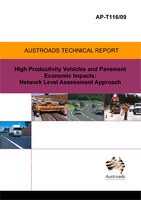Asset Management

- Publication no: AP-T116-09
- ISBN: 978-1-921551-02-4
- Published: 27 January 2009
- PDF (free) Download
The composition of the Australian heavy vehicle fleet has changed over time and no doubt will continue to change in response to pressures to achieve maximum economic benefits. Considering the predicted doubling in the road freight task by 2020, the introduction of high productivity vehicles (HPV), there is a need for developing improved analytical tools and approaches to quantify the likely impacts of these changes on pavement wear and associated economics. The development of improved tools will also assist road agencies in supporting Council Of Australian Governments reforms relating to route access/asset utilisation and full implementation of High Mass Limit.
This report describes an approach/method for assessing and quantifying the economic impacts (costs and benefits) of changes in heavy vehicle fleet on road pavements at network level. The application of the approach is demonstrated by an example simulating the impacts of migration to HPV.
The economic and functional impacts of HPV were quantified at national composite network level using a life cycle costing approach. The assessment involved comparative analysis of the changes in agency and user costs associated with a scenario relative to a base case. The base case included the current fleet, operating under GML and related pavement loading. The scenario included a combination of HPV and their associated pavement loading. In developing the scenario, it was assumed that the new fleet will perform the same transport task as the current fleet it is replacing. Growth in the freight task was applied for the base case and the scenario.
Considering the fleet scenario tested and the assumptions made, the assessment results at network level indicate that migration to HPV has a net benefit due to the productivity gains. This scenario is associated with savings in both agency and user costs due to the reduction in the number of heavy vehicles and pavement wear. The reduction in the number of vehicles required to perform the freight task would also have social, environmental and economic benefits, which were not quantified.
- AP-T116-09 High Productivity Vehicles and Pavement Economic Impacts: Network Level Assessment Approach
- SUMMARY
- CONTENTS
- TABLES
- FIGURES
- 1. INTRODUCTION
- 1.1. Aim
- 1.2. Economic Impacts of HPV at Network Level
- 2. ASSESSMENT APPROACH
- 2.1. Assessment Needs
- 2.2. Assessment Process
- 2.3. Assumptions
- 3. PILOT NATIONAL COMPOSITE NETWORK
- 4. HEAVY VEHICLE FLEET
- 4.1. Current Fleet
- 4.2. Future Fleet
- 5. PAVEMENT WEAR
- 5.1. Pavement Wear Caused by Individual Vehicles
- 5.2. Annual Number of Vehicles
- 5.3. Annual Pavement Wear on Each Section of the Network
- 5.4. Fleet Distribution and Growth
- 5.5. Growth Rates for Number of Vehicles and ASAR
- 6. FLEET AND LOADING SCENARIOS
- 6.1. Base Case
- 6.2. Migration Scenario
- 6.3. Impact of Scenario on Wear of Different Pavement Types
- 7. IMPACTS OF SCENARIOS ON AGENCY COSTS
- 7.1. PLCC Analysis
- 7.2. Approach for Assessing Impacts of Scenarios on Agency Costs
- 7.3. Results
- 7.4. Discussion
- 7.5. Impacts on Agency Costs by Pavement Type
- 8. IMPACTS OF SCENARIOS ON ROAD USER COSTS
- 8.1. PLCC RUC Models
- 8.2. Impacts of Scenarios on RUC
- 8.3. Discussion
- 9. ENVIRONMENTAL AND SAFETY IMPACTS
- 9.1. Definition of Environmental and Safety Impacts
- 9.2. Environmental Impacts of HPV
- 9.3. Safety Implications of HPV
- 9.4. Congestion
- 9.5. Summary
- 10. ECONOMIC EVALUATION
- 10.1. Net Benefits of Future Fleet Scenario
- 10.2. Agency Unit Costs by Road Section
- 10.3. Discussion
- 11. CONCLUSIONS
- 12. REFERENCES
- APPENDIX A DEVELOPMENT OF THE COMPOSITE NATIONAL ROAD NETWORK
- APPENDIX B CURRENT FLEET AND GTK
- APPENDIX C PAVEMENT WEAR CAUSED BY INDIVIDUAL VEHICLES
- APPENDIX D NUMBER OF VEHICLES USING THE NETWORK
- APPENDIX E LOADING SYSTEM
- APPENDIX F EXAMPLE OF SCENARIO APPLICATION
- APPENDIX G IMPACTS OF SCENARIO ON PAVEMENT WEAR AND NUMBER OF VEHICLES
- APPENDIX H ARRB PAVEMENT LIFE CYCLE COSTING MODEL
- APPENDIX I MODIFIED PLCC ROAD USER COST MODELS
- INFORMATION RETRIEVAL
